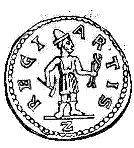Kabiren

Kabiren ( ancient Greek Κάβειροι Kábeiroi , German 'the great [gods], the mighty' , Latin Cabiri ) were chthonic deities who were worshiped in ancient Greece, especially on the North Aegean islands of Samothraki and Lemnos (see cult of the great gods ), but beyond also found worship in Egypt and Phenicia . The Greeks apparently borrowed this secret mystery cult from the Phrygians in Anatolia. Although the origin of the term Kabiren is Semitic or Phoenician ( kabir "big"), nothing indicates that the cult also has its origins in Phenicia.
Originally there were only two gods: an older one, later assigned as Hephaistus or (in Boeotia ) with Dionysus , and a younger one, called Kadmilos or Kasmilos, and often identified with Hermes or the Theban Kadmos or the Trojan Dardanos . When her worship became closely connected with the cult of Demeter and Kora or Rhea , a female Kabirin also appeared. Of the four traditional names of gods, which are known from the mysteries of the Kabiren, probably from Thebes , Axieros, Axiokersa, Axiokersos and Kadmilos, it was claimed that they denoted Demeter, Persephone , Hades and Hermes. On Samothrace they were the protectors of seafarers and castaways.
The Kabiren of Lemnos appear as three sons of Hephaestus and Kabeiro and were blacksmiths, which is why they were called Hephaistoi, which puts them in a relationship with the Telchines , those divine artists who are said to have shaped the first statues of gods from ore in a human image.
A kabir is depicted with hammer and pliers on the reverse of an Antoninian (a Roman coin) of Claudius II (268–270 AD Roman emperor) with the inscription REGI ARTIS (The King of Art). It is one of many examples of an alien cult that the Romans adopted into their own mythology.
In Johann Wolfgang von Goethe , Faust. For the second part of the tragedy , the appearance of the Kabiren prepares the climax of the second act, from verse 8070 onwards. The question of their number is also taken up in a humorous way, about which there were different opinions in Goethe's time.
literature
- Leo Bloch : Megaloi Theoi . In: Wilhelm Heinrich Roscher (Hrsg.): Detailed lexicon of Greek and Roman mythology . Volume 2.2, Leipzig 1897, Col. 2522-2541 ( digitized version ).
- Walter Burkert : Greek religion of the archaic and classical epoch. Kohlhammer, Stuttgart 1977, ISBN 3-17-004345-5 .
- Hartmut Ehrhardt: Samothrace. Shrines in their landscape and history as witnesses to ancient spiritual life. Urachhaus, Stuttgart 1985, ISBN 3-87838-408-4 .
- Bengt Hemberg: The Kabiren. Almqvist & Wiksell, Uppsala 1950.
- Karl Kerényi : The mythology of the Greeks I. The gods and human stories. 23rd edition. dtv, Munich 2003, ISBN 3-4233-0030-2 (first published 1966).
- Paul Wolters et al. a .: The Kabiren shrine at Thebes. 6 volumes, Gruyter, Berlin 1940–1980.
Web links
- Aaron J. Atsma: Cabeiri: Gods of the Samothracian Mysteries. In: The Theoi Project: Greek Mythology. Retrieved September 25, 2014 (English, translated original sources and images; 2000–2011).

